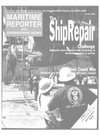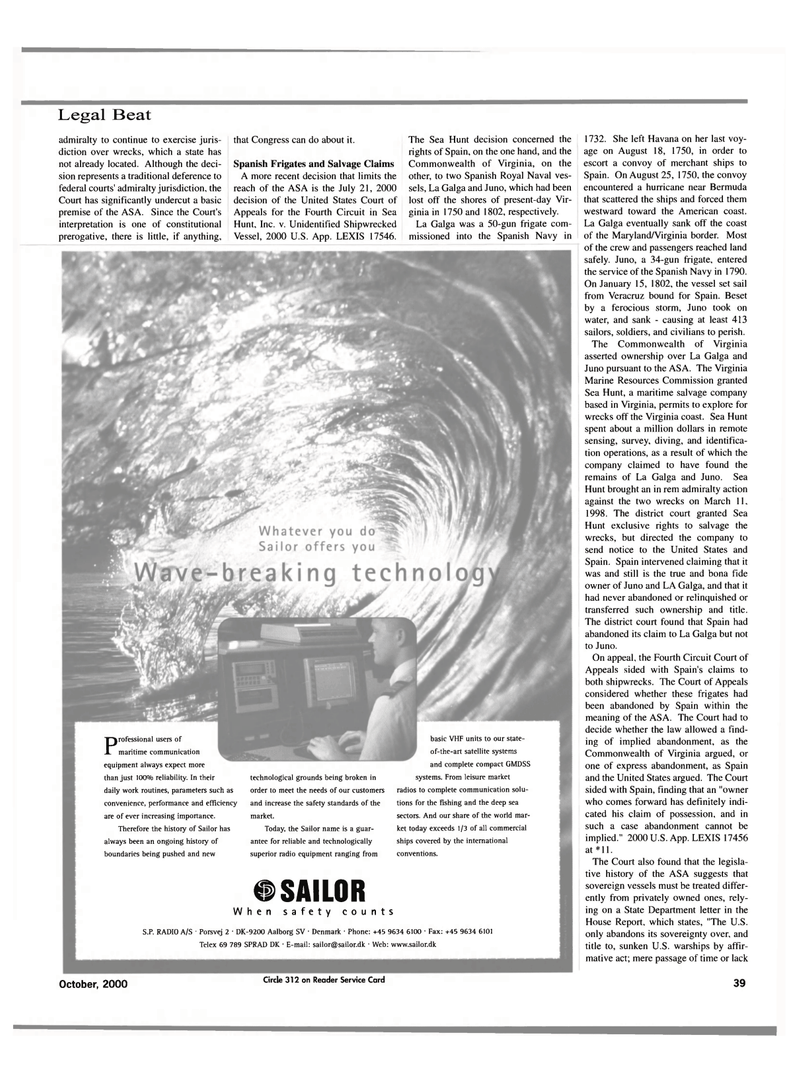
Page 41: of Maritime Reporter Magazine (October 2000)
Read this page in Pdf, Flash or Html5 edition of October 2000 Maritime Reporter Magazine
Legal Beat 1732. She left Havana on her last voy- age on August 18, 1750, in order to escort a convoy of merchant ships to
Spain. On August 25, 1750, the convoy encountered a hurricane near Bermuda that scattered the ships and forced them westward toward the American coast.
La Galga eventually sank off the coast of the Maryland/Virginia border. Most of the crew and passengers reached land safely. Juno, a 34-gun frigate, entered the service of the Spanish Navy in 1790.
On January 15, 1802, the vessel set sail from Veracruz bound for Spain. Beset by a ferocious storm, Juno took on water, and sank - causing at least 413 sailors, soldiers, and civilians to perish.
The Commonwealth of Virginia asserted ownership over La Galga and
Juno pursuant to the ASA. The Virginia
Marine Resources Commission granted
Sea Hunt, a maritime salvage company based in Virginia, permits to explore for wrecks off the Virginia coast. Sea Hunt spent about a million dollars in remote sensing, survey, diving, and identifica- tion operations, as a result of which the company claimed to have found the remains of La Galga and Juno. Sea
Hunt brought an in rem admiralty action against the two wrecks on March 11. 1998. The district court granted Sea
Hunt exclusive rights to salvage the wrecks, but directed the company to send notice to the United States and
Spain. Spain intervened claiming that it was and still is the true and bona fide owner of Juno and LA Galga, and that it had never abandoned or relinquished or transferred such ownership and title.
The district court found that Spain had abandoned its claim to La Galga but not to Juno.
On appeal, the Fourth Circuit Court of
Appeals sided with Spain's claims to both shipwrecks. The Court of Appeals considered whether these frigates had been abandoned by Spain within the meaning of the ASA. The Court had to decide whether the law allowed a find- ing of implied abandonment, as the
Commonwealth of Virginia argued, or one of express abandonment, as Spain and the United States argued. The Court sided with Spain, finding that an "owner who comes forward has definitely indi- cated his claim of possession, and in such a case abandonment cannot be implied." 2000 U.S. App. LEXIS 17456 at *11.
The Court also found that the legisla- tive history of the ASA suggests that sovereign vessels must be treated differ- ently from privately owned ones, rely- ing on a State Department letter in the
House Report, which states, "The U.S. only abandons its sovereignty over, and title to, sunken U.S. warships by affir- mative act; mere passage of time or lack admiralty to continue to exercise juris- diction over wrecks, which a state has not already located. Although the deci- sion represents a traditional deference to federal courts' admiralty jurisdiction, the
Court has significantly undercut a basic premise of the ASA. Since the Court's interpretation is one of constitutional prerogative, there is little, if anything. that Congress can do about it.
Spanish Frigates and Salvage Claims
A more recent decision that limits the reach of the ASA is the July 21, 2000 decision of the United States Court of
Appeals for the Fourth Circuit in Sea
Hunt, Inc. v. Unidentified Shipwrecked
Vessel, 2000 U.S. App. LEXIS 17546.
The Sea Hunt decision concerned the rights of Spain, on the one hand, and the
Commonwealth of Virginia, on the other, to two Spanish Royal Naval ves- sels, La Galga and Juno, which had been lost off the shores of present-day Vir- ginia in 1750 and 1802, respectively.
La Galga was a 50-gun frigate com- missioned into the Spanish Navy in
Professional users of maritime communication equipment always expect more than just 100°/o reliability. In their daily work routines, parameters such as convenience, performance and efficiency are of ever increasing importance.
Therefore the history of Sailor has always been an ongoing history of boundaries being pushed and new technological grounds being broken in order to meet the needs of our customers and increase the safety standards of the market.
Today, the Sailor name is a guar- antee for reliable and technologically superior radio equipment ranging from basic VHF units to our state- of-the-art satellite systems and complete compact GMDSS systems. From leisure market radios to complete communication solu- tions for the fishing and the deep sea sectors. And our share of the world mar- ket today exceeds 1/3 of all commercial ships covered by the international conventions. • SAILOR
When safety counts
S.P. RADIO A/S • Porsvej 2 • DK-9200 Aalborg SV • Denmark • Phone: +45 9634 6100 • Fax: +45 9634 6101
Telex 69 789 SPRAD DK • E-mail: [email protected] • Web: www.sailor.dk
October, 2000 Circle 312 on Reader Service Card 39

 40
40

 42
42
